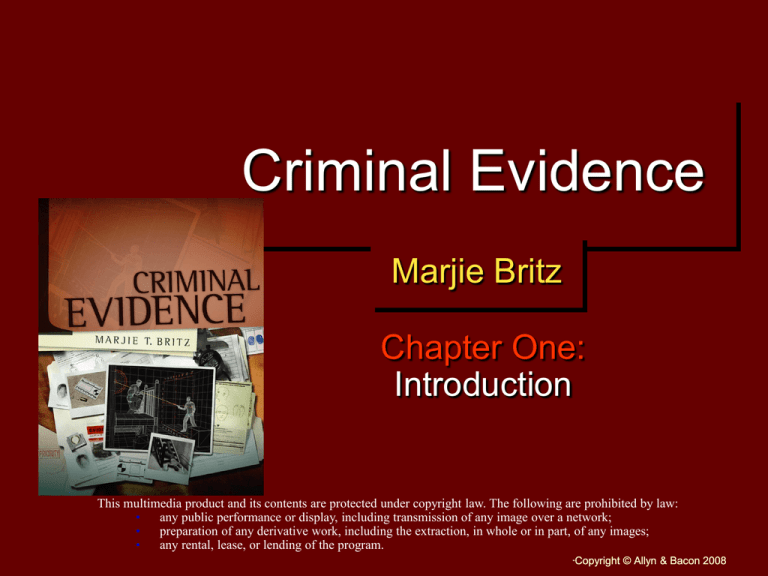Rules of Evidence - Bakersfield College
advertisement

Criminal Evidence Marjie Britz Chapter One: Introduction This multimedia product and its contents are protected under copyright law. The following are prohibited by law: • any public performance or display, including transmission of any image over a network; • preparation of any derivative work, including the extraction, in whole or in part, of any images; • any rental, lease, or lending of the program. “ Copyright © Allyn & Bacon 2008 History of Law and Legal Process Law: the codification of social norms and expectations Evidence: the demonstration of truth or untruth regarding allegations made within a court of law John Wigmore: the father of evidence law Identified 16 legal systems throughout history “ Copyright © Allyn & Bacon 2008 History of Law and Legal Process Code of Hammurabi (circa 2270 B.C.): the oldest known legal code in the world Common law: a compilation of judge-made law; established in England which spread to much of the English-speaking world Civil Law: developed during the Roman Empire and was modernized by the French in the Ninth Century under the direction of Napoleon Bonaparte “ Copyright © Allyn & Bacon 2008 History of Law and Legal Process Stare decisis: requires courts to adhere to legal precedent, i.e. the law as decided by the highest court within a jurisdiction Civil law (legislative law) is composed of law established by government entities “ Copyright © Allyn & Bacon 2008 Sources of Law in Am. System American legal system is based both upon federal and state law State are sovereign No federal sovereign law However, states may not violate rights guaranteed to all American citizens under the Constitution and/or the Bill of Rights “ Copyright © Allyn & Bacon 2008 Sources of Law in Am. System Little wording in the original Constitution directly addressed criminal law and evidence However, the first Ten Amendments of the Constitution (i.e. the Bill of Rights) corrected this oversight “ Copyright © Allyn & Bacon 2008 Sources of Law in Am. System 1st Amendment: freedom of speech 2nd Amendment: right to bear arms 3rd Amendment: protects homeowners from governmental abuse 4th Amendment: no unlawful searches and seizures 5th Amendment: right to a grand jury; freedom from double jeopardy; freedom from selfincrimination; the right to due process; right to just compensation (Govt. Taking) “ Copyright © Allyn & Bacon 2008 Sources of Law in Am. System 6th Amendment: right of speedy and public trial; right to impartial jury of one’s peers; right to be informed of the charges; right to confront witnesses; right to subpoena; right to counsel 7th Amendment: right to a trial by jury (limited scope) 8th Amendment: no excessive bail or unusual punishment 9th Amendment: rights outside Constitution 10th Amendment: ensures states’ rights “ Copyright © Allyn & Bacon 2008 Rules of Evidence Majority of evidence law founded upon common law principles, e.g. relevancy, competency, hearsay, and privileged communications “ Copyright © Allyn & Bacon 2008 Rules of Evidence Uniform Rules of Evidence: enacted in 1974; most states have adopted to help ensure that similar evidence rules applied to all states; still differences exist Federal Rules of Evidence: ensures same application of law among federal courts Civil law replaced common law for evidence rules “ Copyright © Allyn & Bacon 2008 Rules of Evidence On federal level, law is also a product of legislation established by Congress and rulings issued by the Supreme Court “ Copyright © Allyn & Bacon 2008 Defining Evidence Evidence: means of establishing the truth or untruth of a disputed fact Relevant evidence: material evidence having probative value regarding something at issue Material evidence: evidence which is logically connected to a fact at issue “ Copyright © Allyn & Bacon 2008




